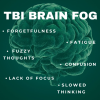Attention is the process of concentrating on specific information in the environment. It allows us to screen out irrelevant information and focus on what is important. There are two forms of attention: passive attention and active attention. Passive attention is the ability to focus on something involuntarily (i.e., a sudden loud noise). It is an automatic process of the mind that is caused by external factors in the environment. Active attention, on other hand, is the ability to focus on something voluntarily (i.e., watching over the kids). This requires effort and conscious attention.
There are five types of attention: focused, sustained, selective, alternating, and divided. Each of these are described below.
| Types of Attention | Definition | Example |
| Focused | Ability to focus on something for any period of time and allows us to quickly detect relevant stimuli |
|
| Sustained | Ability to focus on something over a long period of time |
|
| Selective | Directing our awareness on a task while all other information in the environment is ignored |
|
| Alternating | Moving between two or more tasks that require different mental capabilities
|
|
| Divided | When a person must divide their focus on two or more things |
|
Individuals with impairment or deficits in attention can experience the following symptoms:
- Difficulty focusing
- Difficulty multitasking
- Difficulty following through or completing tasks
- Forgetfulness
- Absent-mindedness
- Short attention span
However, there are general strategies that individuals with impaired attention can utilize. These include:
| Deficit | Strategies |
| Impaired focused attention |
|
| Impaired sustained attention |
|
| Impaired selective attention |
|
| Impaired alternating attention |
|
| Impaired divided attention |
|
References:
https://www.cdl.org/what-is-attention/
https://www.mayoclinic.org/diseases-conditions/adult-adhd/symptoms-causes/syc-20350878
Hahn, B., Wolkenberg, F. A., Ross, T. J., Myers, C. S., Heishman, S. J., Stein, D. J., Kurup, P. K., & Stein,
- A. (2008). Divided versus selective attention: evidence for common processing mechanisms.Brain research,1215, 137–146. https://doi.org/10.1016/j.brainres.2008.03.058



